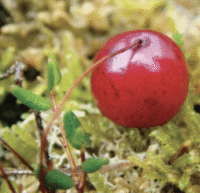What’s so special about bogland biodiversity?
21st May 2025
Ireland’s boglands are home to a variety of plants and animals, many of which cannot be found living in other Irish habitats. To survive in the wet and open bogland habitat the biodiversity of boglands has had to adapt. As National Biodiversity Week is well underway the Irish Peatland Conservation Council are taking this opportunity to share with you an insight into why bogland biodiversity is so special.
Sphagnum mosses are known as the ‘bog builders’. There are over twenty different species of sphagnum moss found on Irish bogs. These bog mosses can hold up to ten times their own weight in water as they have internal specialised cells known as hyaline cells. The ability of sphagnum mosses to store water helps to prevent flooding in communities, one of the many ecosystem services of bogland habitat. Did you also know boglands are the only habitat in Ireland where you will find cranberries growing a food that was traditionally picked to make preserves for the winter ahead?
A bogland is 90% water and 10% dead plants. The surface of a bog is made up of drier hummocks and wetter bog pools. There is a great diversity of invertebrate communities living within these bog pools, including Ireland’s largest spider, the raft spider. Bog pools also act as important nurseries for the larval stages of many species of damselfly and dragonfly. Two of Ireland’s Amphibians the common frog and smooth newt both lay their eggs in bog pools where their young develop. The presence of these bogland invertebrates and Amphibians support bogland bird life including the curlew and snipe both which have long beaks to probe deep under the surface of the bog pools in search of a tasty meal.
The wet and nutrient poor nature of bogland habitats does not support the growth of taller plants as a result all bogland plants are low growing. Bogland birds must nest on the open bogland habitat relying on heather for shelter. Ireland’s insect eating plants, the native sundew and butterwort, have adapted to trap and eat insects rather than depending on absorbing nutrients from peat.
Species such as the large heath butterfly, red grouse, cottongrasses and devil’s matchstick lichen can all be described as iconic bogland biodiversity. What’s so special about bogland biodiversity? The variety of, their quirky adaptations and the many services they provide for us all combine to make bogland biodiversity special. Learn more about bogland biodiversity by visiting www.ipcc.ie.

